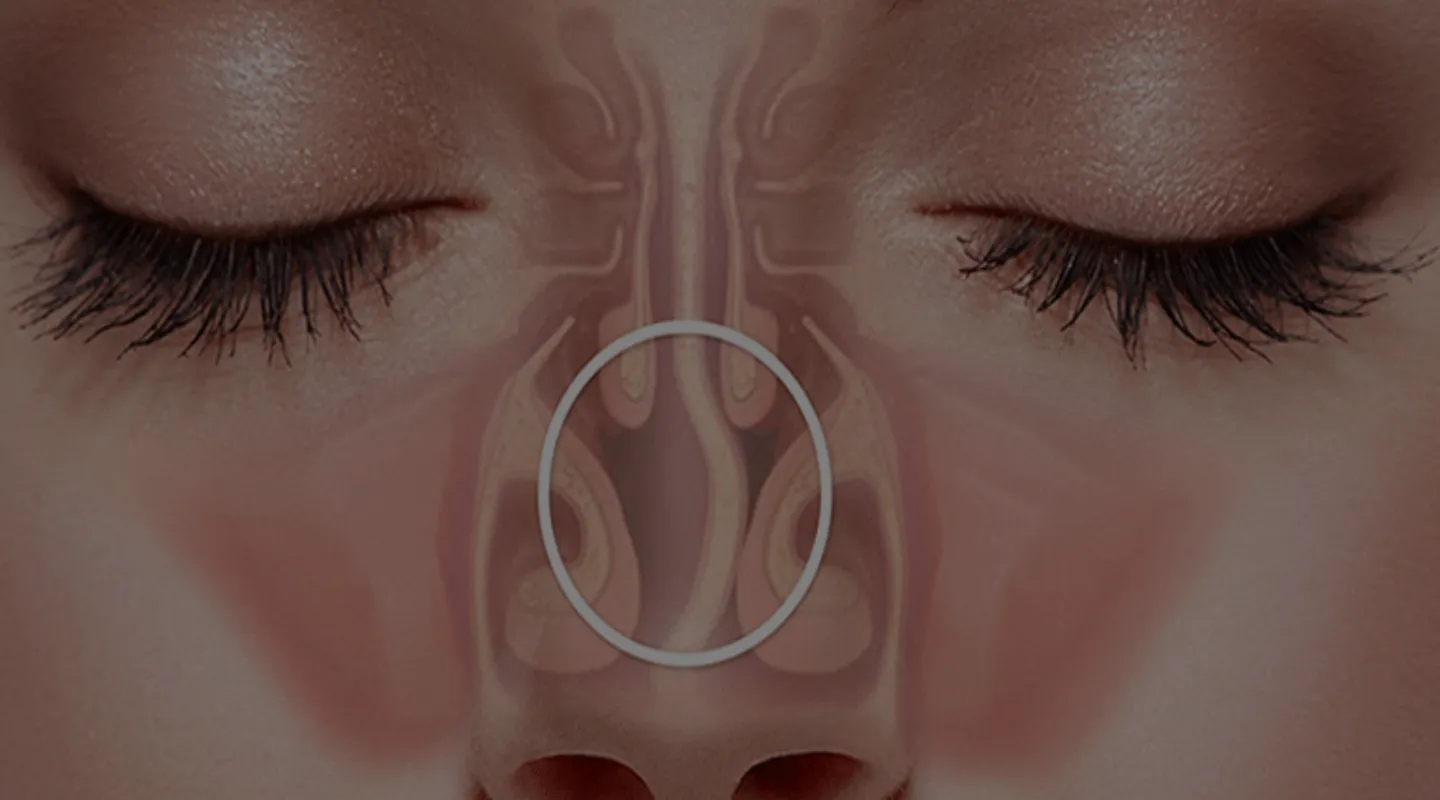
Septoplasty
Your Septoplasty in Tunisia at an Affordable Price
Our ENT specialists correct nasal deviation using modern techniques to improve your breathing and quality of life.
How does it work?
What is Septoplasty?
Septoplasty is a surgical procedure that aims to correct congenital or acquired deviations of the nasal septum. The aim of the operation is to restore the correct airflow in the nasal cavities and allow for normal breathing. A septoplasty operation may be combined with a turbinoplasty in cases where nasal obstruction is also caused by hypertrophy of the turbinates. It may also be called rhinoseptoplasty if combined with an additional rhinoplasty operation for aesthetic purposes.
Who is Septoplasty For?
A patient who is a candidate for septoplasty presents with a deviation or deformation of the nasal septum due to congenital causes or traumatic events. The effects of these pathologies may manifest as persistent nasal congestion, difficulty breathing through one or both nostrils, repeated nosebleeds, dry mouth (xerostomia), or a persistent feeling of pressure inside the nasal cavity.
Deviated Nasal Septum: Causes and Symptoms
A deviated nasal septum occurs when the thin wall of cartilage and bone separating the two nostrils is displaced to one side, causing asymmetry. This deviation can be caused by several factors, including nasal trauma such as sports injuries or accidents, congenital malformations, or uneven growth of nasal structures during adolescence. Symptoms of a deviated nasal septum can vary, but the most common include difficulty breathing through one or both nostrils, frequent sinus infections, nosebleeds, facial pain, and snoring. Some people may also experience recurrent headaches and a sensation of nasal pressure. In severe cases, the deviation can affect quality of life and require surgery called septoplasty to correct the alignment of the septum.
Septoplasty Procedure
Septoplasty, usually performed under general anesthesia, involves realigning the cartilaginous and bony nasal septum. It is usually accompanied by minimal removal of cartilage tissue and, if necessary, volumetric reduction of hypertrophied turbinates. The incision inside the nasal cavity is made at the vestibule level, usually on the left, to allow complete access to the osteo-cartilaginous component. The nasal septum area is then straightened and repositioned into the correct position. At the end of the operation, after suturing with appropriate absorbable material, the surgeon inserts two silicone swabs that do not adhere to the walls of the nose or blood clots, and two small plastic tubes so that the patient can immediately resume breathing.
Post-operative Course and Convalescence
The post-operative course after a septoplasty is generally not painful, but the patient may perceive a feeling of discomfort due to the nasal dressing. There may be slight swelling of the columella area (the lower part of the nose) and the upper lip with pain on palpation, but no visible hematomas on the outer surface of the face. A slight fever is normal (up to 38.5°) until the dressing is removed. Antibiotic treatment will prevent infection. It may be necessary to change the antibiotic prescribed on discharge from the clinic. After removal of the nasal packing, the nasal cavity is suctioned of secretions and treated with antibiotic ointments. In the following days, the patient performs nasal washes with a saline solution (several times a day) at home until the silicone plate is removed, and antibiotic ointments can then be applied until complete healing. Outpatient check-ups (1 to 2 times per week) will be necessary during the following 10 to 15 days, which will be scheduled according to the needs of the case. For a few weeks, the operated nose produces very thick mucus and nasal scabs may form, which must be removed if they cause respiratory obstruction. The patient can usually resume light work or office activities within 4 to 5 days of the operation, while, especially if the patient is exposed to fumes, vapors or dust, it is necessary to wait at least 15 days before returning to work. A return to normal nasal function generally takes 3 to 4 weeks.
Our advantages


Septoplasty Recovery Time
Recovery time after septoplasty varies from person to person, but generally, you should plan for about one to two weeks for initial recovery. During this period, it is normal to experience some discomfort, nasal congestion, and slight bleeding. The doctor may prescribe pain relievers to manage pain and recommend specific care to promote healing, such as avoiding forceful blowing of the nose and sleeping with the head elevated. It is also advisable to avoid strenuous physical activity for at least two weeks to prevent any complications. The majority of patients see significant improvement in their nasal breathing and a decrease in symptoms after a few weeks, but complete healing of the nose can take several months.
Our advantages


Possible Complications and Sequelae Following Septoplasty
While it is impossible to list all the possible complications that can follow any surgical procedure, the following are the most frequently observed after septoplasty.
- Tearing, orbital edema (swelling), headaches. These are generally minor discomforts that depend on the nasal packing. They disappear when the nasal packing is removed;
- Post-operative hemorrhage: This is infrequent and may occur in the first 7 to 8 days. It resolves either by increasing or repeating the nasal packing, depending on the time it occurs;
- Pain in the upper dental arch, especially during chewing. It is caused by the detachment of the base of the septum;
- Nasal septum perforation: A septum perforation results from tearing of the mucosa on both sides and insufficient blood supply to the mucosa. It usually does not cause any particular discomfort, but after a certain time, it can cause slight nosebleeds or the formation of scabs;
- Synechiae: Scars can form between the septum and the lateral walls of the nose, sometimes narrowing the nasal fossa and obstructing the passage of air. If this occurs, they can be removed by a small operation under local anesthesia followed by repacking;
- Failure of the operation: This can be assessed after a few months and may depend on dislocation of the septum, reappearance of the deviation due to the elastic memory of the cartilage, or adhesions between the septum and the lateral wall of the nose due to healing defects that are difficult to predict in advance; it may require a repeat operation;
- Aesthetic deformities: These are exceptional, as the supporting structures of the nasal pyramid are not treated or modified during septoplasty. A realignment of the nasal tip may occur, especially if it is laterally displaced by an anterior deviation of the nasal septum;
- Rhinolic fistula with pneumocephalus: The nasal septum articulates indirectly with the base of the skull and during its remodeling, communication between the skull and the nasal fossa can open;
- Oro-nasal fistula: Communication between the nasal fossa and the oral cavity, with the possibility of infection of the nose and sinuses (rhinosinusitis). This complication requires surgery to ensure closure if healing does not occur spontaneously;
- Orbital lesions, meninges, loss of smell;
Contact and Quote Request for Septoplasty
If you are considering having Septoplasty, do not hesitate to contact Tunisia Destination Santé. Our team is always at your disposal to assist and guide you through all the procedures. Feel free to contact us for more information and to request a free, no-obligation quote.
Your health, our priority.
Request your free quote.
Frequently Asked Questions
Septoplasty can improve nasal breathing, which is crucial for high-level athletes who require optimal oxygenation for peak performance. Better breathing can also improve sleep and recovery.
Yes, after septoplasty, some patients may experience an improvement in their olfactory perception if their initial nasal obstruction has impaired their ability to smell. However, this improvement is not guaranteed.
Complete recovery can take 4 to 6 weeks. However, most patients can resume light activities after one week, avoiding strenuous physical exertion.
Yes, septoplasty is often combined with rhinoplasty (cosmetic correction of the nose) or turbinectomy (reduction of the nasal turbinates) for optimal functional and aesthetic results.
By correcting the deviation of the nasal septum, septoplasty can reduce nasal obstructions, improve breathing and decrease symptoms of sleep apnea, thus contributing to more restful sleep.
Risks include bleeding, infections, septal perforation, loss of smell, unsatisfactory aesthetic results, and persistence of respiratory problems.
For minor septal deviations, non-surgical treatments such as nasal sprays and decongestants may provide temporary relief, but only surgery can offer permanent correction.
Signs include chronic breathing difficulties, recurrent nasal infections, frequent sinusitis, regular nosebleeds, and persistent nasal obstruction that does not respond to medical treatment.
Septoplasty can improve voice resonance by facilitating freer airflow through the nasal passages, although this effect is generally subtle.
Post-operative care includes the use of saline sprays to keep the nasal passages moist, avoiding forceful nose blowing, sleeping with the head elevated, and following the surgeon’s recommendations regarding medication and activity restrictions.
